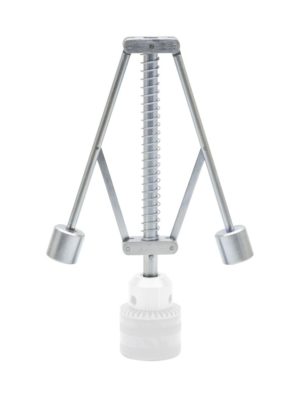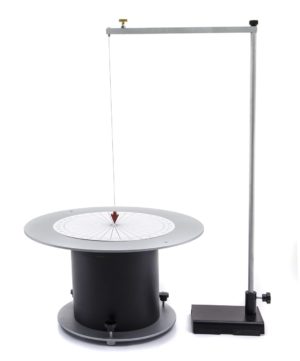• The relativity of motion
• Galileo equations
• Invariant and non-invariant quantities
• The principle of relativity
• Non-inertial references
• Systems with tangential acceleration only
• Motion in two dimensions
• Uniform circular motion
• Centripetal force
• Systems with only radial acceleration
• Rotating platform
• Centrifugal force
• Effects of centrifugal force
• Conical pendulum
• Coriolis force
• Examples of Coriolis forces
• Properties of Coriolis force
• The Earth: a rotating reference system
• The centrifugal force on the Earth’s surface
• Coriolis force on the Earth’s surface
• A proof of the Earth’s rotation: Foucault pendulum
1. Centripetal force
2. A fictitious force: the centrifugal force (needed: Apparatus for centrifugal force 1445)
3. Lack of centripetal force: what happens?
4. Centrifugal forces in equilibrium (needed: Coaxial cylinders 1447)
5. How to use centrifugal force to separate a mixture (needed: Apparatus with inclined test tubes 1082)
6. Centrifugal force and Earth shape (needed: Apparatus with elastic rings 1094)
7. Watt’s regulator (needed: Watt’s regulator 1093)
8. White light: Newton’s Disk (needed: Newton’s Disk 1097)
9. Conical pendulum
10. Properties of conical pendulum (needed: Conical pendulum 1450)
11. How to verify centripetal and centrifugal forces formula (needed: Conical pendulum 1450)
12. Another fictitious force: Coriolis force (needed: Apparatus for Coriolis force 1451)
13. Coriolis force acting on a water jet (needed: Apparatus for water jet 1452)
14. Coriolis force acting on a pendulum (needed: Simple pendulum 1453)
15.Observer in a non-inertial system (needed: Simple pendulum 1453)
16. How to verify Coriolis law with an experiment (needed: Apparatus for Coriolis force 1451)
17. When Coriolis force is zero (needed: Apparatus for falling water 1458)
18. Foucault’s pendulum (needed: Simple pendulum 1453)
- Centrifugal force measuring device for force sensor 1135-SENS or with dynamometer 1135
- Camera kit 1455
- Apparatus for centrifugal force 1445 (To performe experiment n° 2)
- Coaxial cylinders 1447 (To performe experiment n° 4)
- Apparatus with inclined test tubes 1082 (To performe experiment n° 5)
- Apparatus with elastic rings 1094 (To performe experiment n° 6)
- Watt’s regulator 1093 (To performe experiment n° 7)
- Newton’s Disk 1097 (To performe experiment n° 8)
- Bowl with dye 1459 (To be used with code 1452 and code 1458.)
- Conical pendulum 1450 (To performe experiments n° 9-10-11.)
- Apparatus for Coriolis force 1451 (To performe experiments n° 12-16.)
- Simple pendulum 1453 (To performe experiments n°14-15-18.)
- Apparatus for water jet 1452 (To performe experiment n° 17.)
- Apparatus for falling water 1458 (To performe experiment n° 17.)














